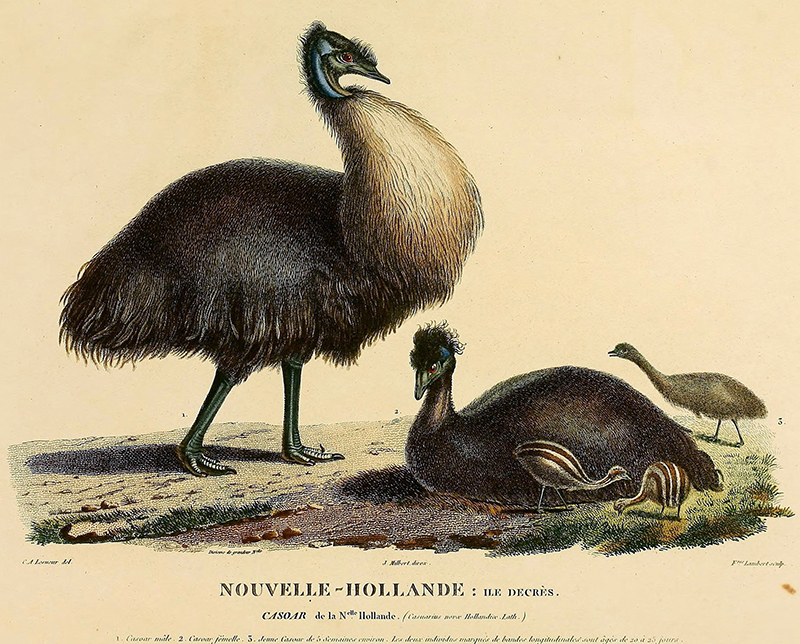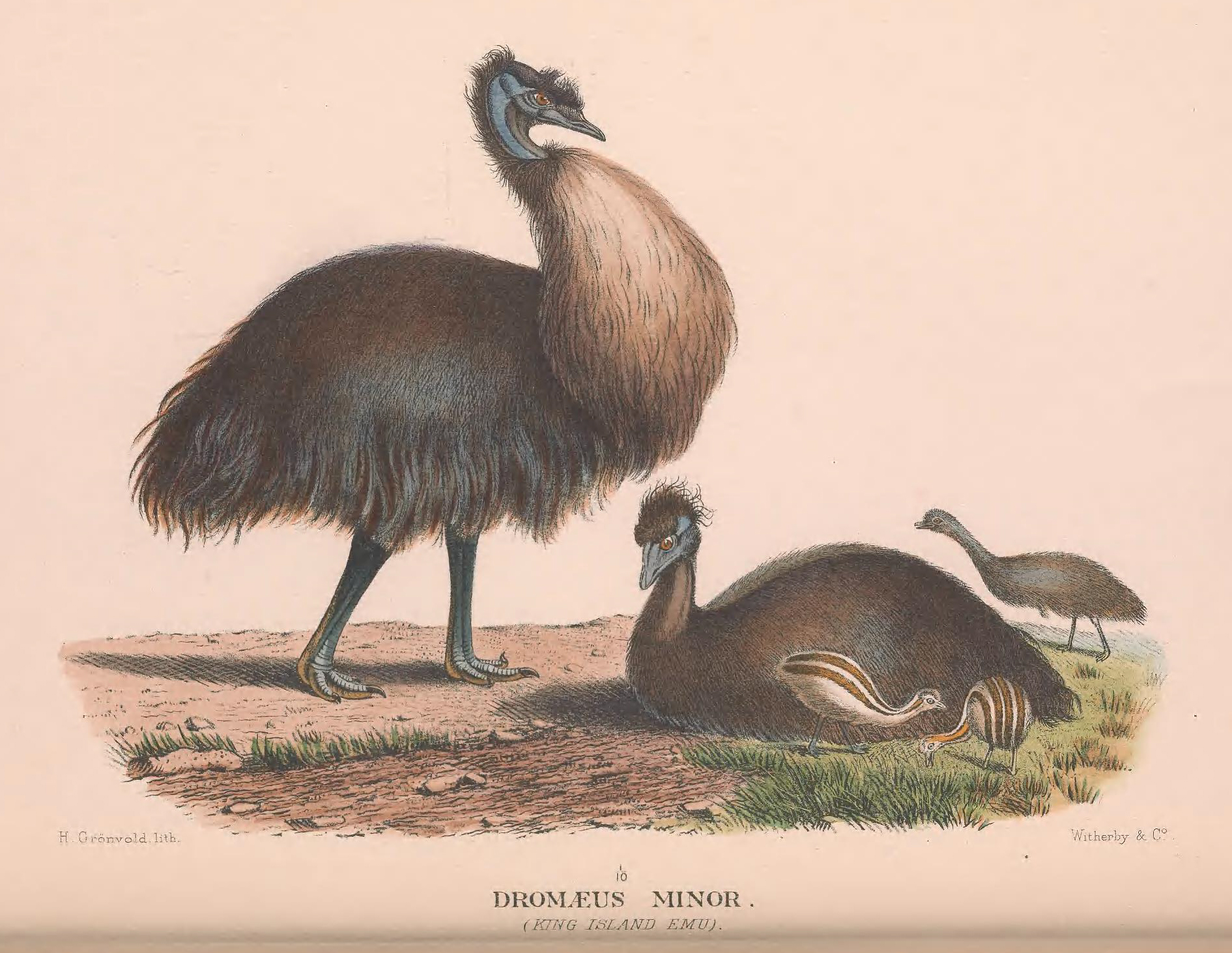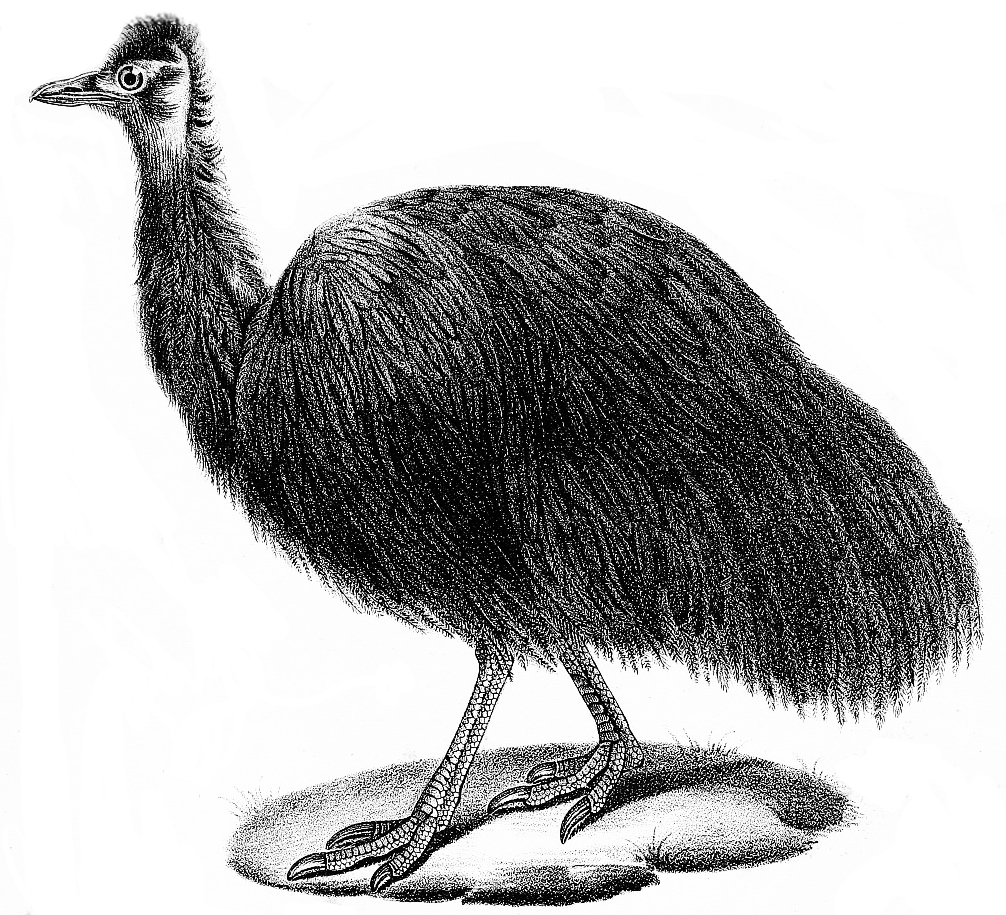Dromaius novaehollandiae minor Spencer, 1906:140
King Island (dwarf) emu, Black emu
Taxonomy & Nomenclature
Synonym/s: Dromaius ater Vieillot, 1817 (nomen novum for D. n. novaehollandiae?); Dromaius novaehollandiae ater Vieillot, 1817 (nomen novum for D. n. novaehollandiae?); Casuarius diemenianus Jennings, 1828:382; Dromaeus parvulus 'Gould' (fide Broderip, 1842:145); Dromaeus minor Spencer, 1906:140; Dromaeus bassi Legge, 1907:119
Dromaius (novaehollandiae) ater appears to be a nomen novum ("new name") for the living nominate form D. n. novaehollandiae, hence its use in connection with the current taxon is probably in error.
Generally considered a full species nowadays (e.g. BirdLife International, 2008), a new article (Heupink, Huynen & Lambert, 2011) provides convincing evidence that the King Island Emu is, rather, a subspecies of the mainland population of emus.
Conservation Status
Extinct
Last record: 1805 (Anonymous, 1994; Kittelberger et al., 2024); May 1822
IUCN RedList status: Extinct
According to (Le Souef, 1904) a sealer named Cowper told men from Baudin's 1802-1803 expedition that he had killed around 300 hundred of the resident emus on King Island. This no doubt had a significant impact on the population, and may itself have been enough to push the population past the viability threshold and into inevitable extinction.
Distribution
King Island, Tasmania, Australia
Biology & Ecology
Hypodigm
Media

Above: an illustration by Charles-Alexandre Lesueur (c.1808-1811). Possibly depicting a Kangaroo Island emu (standing) and King Island emu (laying down) (see Pfennigwerth, 2010b). Source: Wikimedia Commons.

Above: illustration by Henrik Grønvold based upon the one above by Charles-Alexandre Lesueur, published in (Mathews, 1910-1911:pl.4).

Above: specimen in the Muséum national d'Histoire naturelle. Source: Wikimedia Commons.
References
Original scientific description:
Spencer, Baldwin. (1906). The King Island Emu. The Victorian Naturalist 23(7): 139-140.
Other references:
Alexander, W. B. (1921). Notes on the Fauna of King Island from the Logbooks of the "Lady Nelson". Emu 21(4): 318-319.
Anonymous. (1994). Fauna reintroductions in the Australian arid zone: recent update. Wanted Alive 4: 3-4.
Antonius, Edwin. (2017). Emus von King Island und Kangaroo Island in Europa – Neue Erkenntnisse über 1804 von der Baudin-Expedition mitgebrachte Vertreter inzwischen ausgerotteter Laufvögel. Der Zoologische Garten 86(1-6): 41-76. [Abstract]
Balouet, Jean-Christophe and Jouanin, Christian. (1990). Systématique et origine géographique des émeus récoltés par l’expédition Baudin. L’Oiseau et la Revue française d’ornithologie 60: 314-318.
Barnard, G. (1826-1827). A descriptive map of rocks, timber and soil on King's Island. Lt. Gov. Arthur's Despatch 73. Governor's despatches, October to December 1827. London: Colonial Records Office.
BirdLife International (2000) Threatened Birds of the World. Lynx Edicions and BirdLife International, Barcelona and Cambridge.
BirdLife International. (2012). Dromaius ater. In: IUCN 2012. IUCN Red List of Threatened Species. Version 2012.1. (http://www.iucnredlist.org). Downloaded on 30 September 2012.
BirdLife International. 2016. Dromaius minor. The IUCN Red List of Threatened Species 2016: e.T22728643A94992893. https://dx.doi.org/10.2305/IUCN.UK.2016-3.RLTS.T22728643A94992893.en. Accessed on 30 June 2022.
Boles, Walter E. (1992). Revision of Dromaius gidju Patterson & Rich 1987 from Riversleigh, northwest Queensland, Australia, with a reassessment of its generic position. Contributions to the Los Angeles County Museum of Natural History [1992]: 195-208.
Brasil, L. (1913). L’Émeu de l’île King. Bulletin de la Société Linnéenne de Normandie, 6(6): 76-97.
Brasil, L. (1914). The Emu of King Island. Emu 14(2): 88-97.
Brooks, T. 2000. Extinct species. In: BirdLife International (ed.), Threatened Birds of the World, pp. 701-708. Lynx Edicions and BirdLife International, Barcelona and Cambridge, U.K.
Brosse, J. 1983. Great Voyages of Discovery; Circumnavigators and Scientists, 1764-1843. Facts on File Publ., New York.
Bryant, Sally L. and Jackson, J. (1999). Tasmania's Threatened Fauna Handbook: What, Where and How to Protect Tasmania's Threatened Animals. Threatened Species Unit, DPIWE, Hobart. [p. 213-215]
Bullock, William. (1813). A companion to the London Museum and Pantherion : containing a brief description of upwards of fifteen thousand natural and foreign curiosities, antiquities, and productions of the fine arts now open for public inspection in the Egyptian Temple, Piccadilly, London. London: Printed for the proprietor by Whittingham and Rowland. xii + 151 pp. [pp. 67]
Campbell, A. G. (1903). Emu bones on King Island. Emu 3(2): 113-114.
Christidis, L. and Boles, W.E. 2008. Systematics and Taxonomy of Australian Birds. CSIRO Publishing, Collingwood, Australia.
Fishburn, Matthew. (2022). Dwarf emus from Baudin's voyage (1800–1804): an overlooked engraving by Nicolas Huet (1770–1830). Archives of Natural History 49(2): 285-297. https://doi.org/10.3366/anh.2022.0791
Frith, H. J. (1979). Wildlife Conservation, revised edition. Angus & Robertson. xiv + 416 pp. [p. 56, p. 295, p. 308 (species account)]
Garnett, Stephen (ed.). (1992). Threatened and Extinct Birds of Australia. RAOU Report Number 82. 212 pp.
Garnett, S. T. and Crowley, G. M. (2000). The Action Plan for Australian Birds 2000. Canberra, ACT: Environment Australia & Birds Australia.
Ghiraldi, Luca and Aimassi, Giorgio. (2019). Extinct and endangered (‘E&E’) birds in the ornithological collection of the Museum of Zoology of Torino University, Italy. Bulletin of the British Ornithologists’ Club 139(1): 28-45.
Giglioli, Henry H. (1900). A Third Specimen of the Extinct "Dromaius ater," Vieillot; found in the R. Zoological Museum, Florence. Nature 62(1596): 102. [Abstract]
Giglioli, Henry H. (1901). On a Specimen of the Extinct Dromæus ater Discovered in the Royal Zoological Museum, Florence. Ibis 43(1): 1-10. [Abstract]
Giglioli, Henry H. (1907). On the extinct emu of the small islands off the south coast of Australia and probably Tasmania. Nature 75: 534.
Green, R. H. (1989). Birds of Tasmania. Launceston: Potoroo Publishing.
Green, R. H. and McGarvie, A. M. (1971). The birds of King Island, with reference to other western Bass Strait islands and annotated lists of the vertebrate fauna. Records of the Queen Victoria Museum 40: 1-42.
James C. Greenway, Jr. (1967). Extinct and vanishing birds of the world, second edition. Dover Publications, Inc., New York.
Hall, Robert. (1899). A Key to the Birds of Australia and Tasmania ; with their geographical distribution in Australia. Melbourne/London, Melville Mullen & Slade / Dulau & Co.
Heupink, T. H., Huynen, L. and Lambert, D. M. (2011). Ancient DNA Suggests Dwarf and ‘Giant’ Emu Are Conspecific. PLoS ONE 6(4): e18728.
Hooper, Richard H. (1973). The King Island Story, edited by Mark Richmond. Sydney: Peko-Wallsend. [p. 24]
del Hoyo, J., Collar, N.J., Christie, D.A., Elliott, A. and Fishpool, L.D.C. 2014. HBW and BirdLife International Illustrated Checklist of the Birds of the World. Volume 1: Non-passerines. Lynx Edicions BirdLife International, Barcelona, Spain and Cambridge, UK.
Hume, Julian Pender. (2017). In search of the dwarf emu: extinct emus of Australian islands. Talk to be presented on Monday 13 March to the British Ornithologists' Club. [Abstract]
Hume, Julian Pender and Robertson, Christian. (2021). Eggs of extinct dwarf island emus retained large size. Biol. Lett. 17: 20210012. https://doi.org/10.1098/rsbl.2021.0012
Hume, Julian Pender, Steel, Lorna, Middleton, Gregory and Medlock, Kathryn. (2017). In search of the dwarf emu: A palaeontological survey of King and Flinders Islands, Bass Strait, Australia Contribuciones del Museo Argentino de Ciencias Naturales "Bernardino Rivadavia" 7: 81-98.
Hume, Julian Pender and Walters, Michael. (2012). Extinct Birds. London: T & AD Poyser. 544 pp.
Jennings, J. (1828). Ornithologia; or, The Birds: A Poem, in Two Parts with an Introduction to their Natural History; and Copious Notes. London: Poole and Edwards.
Jennings, J. N. (1959). The coastal geomorphology of King Island, Bass Strait, in relation to changes in the relative level of land and sea. Rec. Queen. Vic. Mus. 11.
Jouanin, Christian. (1959). Les emeus de l'Expedition Baudin. L'Oiseau et la Revue Française d'Ornithologie 29(3): 169-203.
Jouanin, Christian. (1962). Inventaire des oiseaux éteints ou en voie d’extinction conservés au Muséum de Paris. Terre et Vie 109: 275-301.
Kittelberger, Kyle D., Tanner, Colby J., Buxton, Amy N., Prewett, Amira and Şekercioğlu, Çağan Hakkı. (2024). Correlates of avian extinction timing around the world since 1500 CE. Avian Research 15: 100213. https://doi.org/10.1016/j.avrs.2024.100213 [Supplementary data (List of 216 taxa)]
Legge, W. V. (1906). The emus of Tasmania and King Island. Emu 6(3): 116-119. [published in 1907?]
Le Souef, D. (1904). Extinct Tasmanian Emu. Emu 3(4): 229-231.
Marchant, S.; Higgins, P. J. 1990. Handbook of Australian, New Zealand and Antarctic birds, 1: ratites to ducks. Oxford University Press, Melbourne.
Martin, Robert Montgomery. (1855). The British Colonies: Their History, Extent, Condition, and Resources. London: London Printing and Publishing, Vol. I, Book I, p. 656.
Mathews, Gregory M. (1911). The Birds Of Australia. London: l, Witherby & Co.
Mathews, G. M. (1927). Systema Avium Australasianarum. A Systematic List of the Birds of the Australasian Region. Vol. 1. London: British Ornithologists’ Union.
Micco, Helen Mary. (1971). King Island and the sealing trade, 1802. Canberra: Roebuck. 52 pp. [relevant citation?]
Milne-Edwards, A. and Oustalet E. (1899). Note sur L'Emeu noir (Dromaius ater, V) de l'ile Deeres (Australie). Bull. Mus. Hist. Nat. 51: 206-14.
Moorehead, A. (1978). Darwin and the Beagle. Book Club Associates. [reproduction of emu family on p. 172*]
O’Brien, R. M. (1990). Family DROMAIIDAE: Emus, p. 59. In: Stephen Marchant and Peter Jeffrey Higgins (coordinators). Handbook of Australian, New Zealand and Antarctic Birds. Vol. I: Ratites to Ducks. Melbourne: Oxford University Press.
Parker, S. A. 1984. The extinct Kangaroo Island Emu, a hitherto-unrecognized species. Bulletin of the British Ornithologists' Club 104: 19-22.
Péron, François. (1804). Voyage de de couvertes aux terres Australes. Paris.
Pfennigwerth, Stephanie Clare. (2007). Of Emus and Empires - The Story of the King Island Emu. Animals and Society II: Considering Animals, conference, 4-7 July 2007, Hobart, Tasmania.
Pfennigwerth, Stephanie Clare. (2010a). New creatures made known: (re)discovering the extinct King Island emu. Research Master thesis, University of Tasmania.
Pfennigwerth, Stephanie Clare. (2010b). “The mighty cassowary”: the discovery and demise of the King Island emu. Archives of Natural History 37(1): 74-90. [Abstract]
Pfennigwerth, Stephanie Clare. (2013). New Creatures Made Known: Some Animal Histories of the Baudin Expedition, pp. 171-213. In: West-Sooby, John. Discovery and Empire: the French in the South Seas. Adelaide: University of Adelaide Press. 282 pp.
Rothschild, Lionel Walter. (1907). Extinct birds: an attempt to write in one volume a short account of those birds which have become extinct in historical times, that is within the last six or seven hundred years: to which are added a few which still exist, but are on the verge of extinction. London: Hutchinson & Co. XXIX + 243 pp. [p. 237]
Royal Australasian Ornithologists Union. (1978). Recommended English Names for Australian Birds. Emu 77(Supplement): 255.
Sadokierski, Zoë and Monin, Monica. (2025). Prompting as Thinking-With: Using Generative AI to Visualise an Extinct Dwarf Emu. ArteActa 8(13).
Sayol, Ferran, Steinbauer, Manuel J., Blackburn, Tim M., Antonelli, Alexandre and Faurby, Søren. (2020). Anthropogenic extinctions conceal widespread evolution of flightlessness in birds. Science Advances 6(49): eabb6095. https://doi.org/10.1126/sciadv.abb6095 [Supplementary Material (Data File S1)]
Serventy, D. L. (1967). The Bass Strait Islands. Australian Natural History 15(12): 401-408.
Slater, P. (1978). Rare and Vanishing Australian Birds. Sydney: Rigby.
Spencer, W. Baldwin and Kershaw, J. A. (1910). A Collection of Sub-fossil Bird and Marsupial Remains from King Island, Bass Strait. Mem. Nat. Mus. Melbourne 3: 5-35.
Spencer, Baldwin and Kershaw, J. A. (1910). A collection of sub-fossil bird and marsupial remains from King Island, Bass Strait. Mem. Nat. Mus. Melb. 3: 5-35.
Stattersfield, A.J., Crosby, M.J., Long, A.J. and Wege, D.C. 1998. Endemic bird areas of the world: priorities for bird conservation. BirdLife International, Cambridge, U.K.
Thomson, Vicki A., Mitchell, Kieren J., Eberhard, Rolan, Dortch, Joe, Austin, Jeremy J. and Cooper, Alan. (2018). Genetic diversity and drivers of dwarfism in extinct island emu populations. Biology Letters 14(4): 20170617. [Abstract]
Tyrberg, Tommy. (2009). Holocene avian extinctions, pp. 63-106. In: Turvey, Samuel T. (ed.). Holocene Extinctions. Oxford, UK & New York, USA: Oxford University Press. xii + 352 pp.
Van Huet, Sanja. (1999). Badgers, cassowaries and oddities: the extant and extinct fauna of King Island, Bass Strait. Abstracts from the 6th CAVEPS, Perth, 7-11 July, 1997. In: Baynes, Alexander and Long, John A. (eds.). Papers in vertebrate palaeontology. Records of the Western Australian Museum Supplement 57: 420.
Vickers-Rich, Patricia. (1975). Antarctic dispersal routes, wandering continents, and the origin of Australia's non-passeriform avifauna. Mem. Nat. Mus. Vic. 36: 63-126.
Vieillot, L. J. P. (1817). Nouveau dictionnaire d'histoire naturelle, volumes 7, 14 & 25. Paris: Déterville.
Woinarski, John C. Z., Braby, M. F., Burbidge, A. A., Coates, D., Garnett, S. T., Fensham, R. J., Legge, S. M., McKenzie, N. L., Silcock, J L. and Murphy, B. P. (2019). Reading the black book: The number, timing, distribution and causes of listed extinctions in Australia. Biological Conservation 239: 108261. https://doi.org/10.1016/j.biocon.2019.108261
Woinarski, John C. Z., Legge, Sarah M. and Garnett, Stephen T. (2024). Extinct Australian birds: numbers, characteristics, lessons and prospects. Emu 124(1): 8-20. https://doi.org/10.1080/01584197.2023.2240345
Worthy, Trevor H. and Nguyen, Jacqueline M. T. (2020). An annotated checklist of the fossil birds of Australia. Transactions of the Royal Society of South Australia 144(1): 66-108.
Worthy, Trevor H., Nguyen, Jacqueline M. T. and Travouillon, Kenny J. (2024). Checklist of the Fossil Bird Species of Australia. Available from: https://www.australasianpalaeontologists.com/national-fossil-species-lists [Accessed 24 November 2024]
Worthy, Trevor H., Nguyen, Jacqueline M. T. and Travouillon, Kenny J. (2025). Checklist of the Fossil Bird Species of Australia. Available from: https://www.australasianpalaeontologists.com/national-fossil-species-lists [Accessed 1 March 2025]
http://extinctanimals.proboards.com/thread/9316/dromaius-ater-king-island-emu
* Can also be seen here
<< Back to the Casuariiformes (Casowaries and Emus) database
